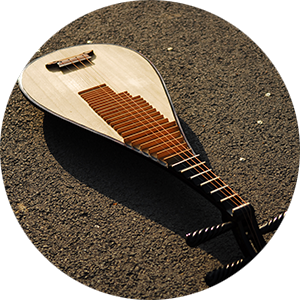
Pipa

Pipa Lessons
Chinese lute Pipa lessons with Lucy Zhao are suitable for beginners and advanced students.
Pipa lessons content overview
- Basic playing skills using left and right hands with supplementary exercises.
- Left hand: pressing strings on the frets; Chinese vibrato (strings tremble slightly to change tone); etc.
- Right hand: tan tiao (basic playing style with thumb and index finger); lun zhi (pipa specific playing style: tremolo with five fingers); etc.
- Basic knowledge of Chinese traditional music
- Tonality: pentatonic
- Notation for Chinese traditional music: number notation
- Traditional and modern works of the pipa (can be chosen according to your wishes)
Learn more about the instrument
One of the most popular Chinese traditional instruments, Pipa is a plucked shell-neck lute based on a pear-type of shape, which may have been existing since the Han dynasty, for more than 2000 years. The instrument has evolved in shape throughout centuries, including as a variety of plucked chordophones but since the Song dynasty (approx. 6th century), the standard pear-shaped Pipa has been widely in use. Having evolved throughout history, Pipa now usually has four strings made of steel, which are tuned A-d-e-a, and running over 24-30 frets. Today, playing is done with the performers own fingernails orartificial ones, and also – but more rarely so – with a plectrum. The name Pipa refers to a basic righthanded playing technique, which is based on the combination of “Pi”(琵) which involves sliding the index finger of the right hand across the strings from right to left, and “Pa”(琶) which involves sliding the thumb in the opposite direction.


